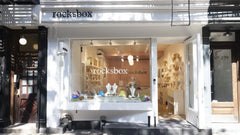
Target Tests Factory-Direct Shipping Model to Compete in Budget Retail Market
Table of Contents
- Key Highlights
- Introduction
- Understanding the Shift to Factory-Direct Shipping
- Challenges Ahead: Regulatory and Economic Factors
- Competitive Landscape: Insights from Rivals
- Case Studies: Lessons from Successful Models
- Looking Ahead: The Future of Retail
- FAQ
Key Highlights
- Target is exploring a new shipping model that would send products directly from factories to consumers, aiming to reduce costs and improve pricing for low-cost items.
- The initiative is a response to declining consumer confidence and increased competition from retailers like Temu and Shein.
- The model's success may be influenced by changes in U.S. import regulations and evolving shopper behavior.
Introduction
In a rapidly evolving retail landscape, where consumers are increasingly price-sensitive, Target has announced a bold new initiative: the testing of a factory-direct shipping model for select low-cost products. This move not only reflects the changing dynamics of consumer spending but also highlights Target's strategy to remain competitive amidst rising challenges from discount retailers like Temu and Shein. With a significant decline in comparable sales reported in recent quarters, the stakes are high for the Minnesota-based retail giant as it seeks innovative ways to attract cost-conscious shoppers.
Understanding the Shift to Factory-Direct Shipping
The traditional retail model typically involves products being shipped from warehouses to customers, which can increase costs due to warehousing and logistics expenses. Target’s new strategy seeks to bypass this model by shipping directly from factories, which could potentially lower prices for consumers on apparel, household goods, and other non-food items. According to a report by Bloomberg, this new approach is being compared to models already in use by competitors such as Temu and Shein, both of which have thrived by offering affordable products directly from manufacturers.
Implications for Pricing and Consumer Behavior
As Target pivots towards this factory-direct shipping model, it positions itself to offer more competitive pricing. This is particularly crucial in an environment where consumer confidence has waned due to inflationary pressures and economic uncertainty. According to Rick Gomez, Target’s Chief Commercial Officer, customers are becoming increasingly selective in their purchases, often prioritizing budget-friendly options. This shift necessitates that retailers like Target adapt swiftly to meet changing consumer expectations.
Historical Context: The Rise of Budget Retailers
The rise of discount retailers in recent years has significantly impacted traditional retail giants. Companies like Temu and Shein have leveraged technology and supply chain efficiencies to offer lower prices, attracting a demographic that prioritizes value over brand loyalty. The emergence of these competitors has forced established retailers, including Target, to reevaluate their business models. The factory-direct approach could be a necessary evolution for Target, allowing it to harness the efficiencies that these new entrants have capitalized on.
Challenges Ahead: Regulatory and Economic Factors
While the potential benefits of a factory-direct shipping model are evident, Target must navigate several challenges. One significant concern is the U.S. government's recent changes to the de minimis exemption, which previously allowed for duty-free imports of goods valued under $800. The closure of this exemption may complicate the logistics of direct shipping, potentially increasing costs and affecting pricing strategies.
Navigating Tariffs and Import Regulations
The shifting landscape of tariffs and import regulations creates uncertainty for retailers. As Target explores this new shipping model, it will need to closely monitor how these regulations impact operational costs and pricing structures. The company’s ability to adapt to regulatory changes will be crucial in determining the success of this initiative.
Consumer Confidence and Spending Trends
Beyond regulatory challenges, Target faces the broader issue of consumer confidence. Recent reports indicated a decline in discretionary spending as households tighten budgets amidst economic uncertainty. The retail sector has seen a shift towards more essential purchases, and retailers that can successfully adapt to these changing consumer priorities will likely thrive.
Competitive Landscape: Insights from Rivals
Target is not alone in its pursuit of cost-saving strategies. Amazon, for instance, has responded to the competitive threat posed by budget retailers by launching its own discount initiative, "Amazon Haul," which offers products priced at $20 or less. This strategic move indicates that even e-commerce giants recognize the necessity of catering to price-sensitive consumers in the current economic climate.
The Race for Budget-Conscious Consumers
The competition to attract budget-conscious shoppers is intensifying, with retailers employing various tactics to capture market share. Temu and Shein have built their brands around affordability and rapid shipping, posing a significant challenge to established players like Target. As these retailers continue to innovate and refine their offerings, Target must act swiftly to maintain its relevance.
Case Studies: Lessons from Successful Models
Several retail companies have successfully implemented direct-to-consumer shipping models, providing valuable insights for Target as it tests its new approach. For example, companies like Warby Parker and Casper have thrived by bypassing traditional retail channels, offering customers direct access to their products and a seamless online shopping experience.
Leveraging Technology and Data
Target can draw lessons from these case studies by leveraging technology and data analytics to optimize its shipping processes. By understanding consumer behavior and preferences, the retailer can refine its inventory management and logistics strategies, ensuring that it meets customer demands effectively.
Looking Ahead: The Future of Retail
As Target embarks on this new shipping experiment, the implications for the future of retail are significant. The success of factory-direct shipping could reshape the company’s operational framework and pricing strategies, potentially setting a precedent for other retailers.
Consumer-Centric Innovations
The focus on consumer-centric innovations will be crucial as Target navigates this transition. The ability to quickly adapt to changing consumer preferences and market conditions will determine the long-term viability of the factory-direct model.
A New Era for Target
In conclusion, Target's exploration of a factory-direct shipping model represents a critical step in its efforts to remain competitive in an increasingly challenging retail environment. By reducing costs and enhancing pricing strategies, the company aims to attract a broader customer base while responding to the evolving dynamics of consumer behavior.
FAQ
What is the factory-direct shipping model being tested by Target?
Target is testing a shipping model that would send products directly from factories to consumers, reducing costs and potentially lowering prices for low-cost items.
How does this model compare to competitors like Temu and Shein?
This model resembles the approaches of Temu and Shein, which have successfully leveraged factory-direct shipping to offer affordable products.
What challenges does Target face with this new shipping model?
Target must navigate regulatory changes regarding import duties, potential increases in operational costs, and the broader issue of declining consumer confidence.
How does consumer behavior impact Target's strategy?
With consumers increasingly focused on budget-friendly options, Target's new shipping model aims to meet their demand for lower prices while adapting to changing spending trends.
What can Target learn from successful direct-to-consumer companies?
Target can learn from companies like Warby Parker and Casper by leveraging technology and data analytics to optimize its shipping processes and enhance the customer experience.
By embracing innovation and understanding the market dynamics, Target is taking a significant step towards redefining its role in the retail landscape, ensuring it remains a relevant player in the quest for budget-conscious consumers.
Power your ecommerce with our weekly insights and updates!
Håll dig uppdaterad om vad som händer i handelsvärlden
E-postadress
Handplockad för dig
25 June 2025 / Blog
Guide Dogs Launches Accessible Beauty Guidelines to Break Barriers for Australians with Disabilities
Läs mer
25 June 2025 / Blog
Forrester’s Total Experience Score: Bridging Customer Experience and Business Success
Läs mer
25 June 2025 / Blog
